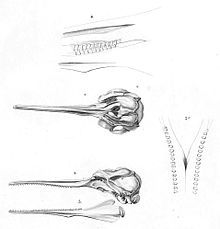La Plata Dolphin
| La Plata Dolphin | ||||||||||||
|---|---|---|---|---|---|---|---|---|---|---|---|---|

La Plata Dolphin ( Pontoporia blainvillei ) |
||||||||||||
| Systematics | ||||||||||||
|
||||||||||||
| Scientific name of the family | ||||||||||||
| Pontoporiidae | ||||||||||||
| JE Gray , 1846 | ||||||||||||
| Scientific name of the genus | ||||||||||||
| Pontoporia | ||||||||||||
| JE Gray , 1846 | ||||||||||||
| Scientific name of the species | ||||||||||||
| Pontoporia blainvillei | ||||||||||||
| ( Gervais & d'Orbigny , 1844) |
The La Plata Dolphin ( Pontoporia blainvillei ), in his home Franciscana called, is one on the Atlantic coast of South America common toothed whale .
features
With a size of 130 to 170 cm (males only up to 1.50 meters) and a weight of 35 to 50 kg (males maximum 40 kg), this river dolphin is graceful in shape. It has a gray-brown body color that becomes lighter towards the belly. The head is small and set off from the torso by a slight fold in the neck. The eyes are small but well developed. The blowhole is sickle-shaped. The snout is the longest of all whales relative to the body and is very slender with a straight mouth line. There are 106 to 116 teeth in the upper jaw and 102 to 116 in the lower jaw. The flippers are wide and almost triangular with a strongly curved front and jagged rear edge, the inner bones can be seen through the skin. The fin has a long base and a slightly rounded tip. The body tapers to the base of the tail. The fluke is extremely wide with up to a third of the body length, has a slightly concave rear edge and a slight indentation in the middle. Young animals have a significantly shorter snout and are around 70 to 80 cm long and 7.3 to 8.5 kg in weight at birth.
distribution
The La Plata dolphin occurs along the east coast of South America from the Rio Doce in Brazil to the Bahía Blanca in Argentina. It lives mainly in shallow coastal waters and estuaries, but hardly penetrates into rivers. The species is most often seen in the estuary of the Río de la Plata , where it seldom stays in winter.
Way of life
The La Plata dolphin feeds on fish , squid, and crustaceans . It will likely find its prey by digging through the muddy ground with its long snout. As a loner he avoids the presence of his fellow species. His dives are short and his stays on the surface are even shorter. After a gestation period of 10 to 11 months, the young are usually born in the southern summer between October and February and suckled for around 9 months. They become sexually mature at two to three years of age and are fully grown at four. The females give birth about every two years. Because of his hidden way of life and shyness, he is rarely seen by people and his behavior is still largely unknown. However, around 1500 La Plata dolphins get caught in fishing nets each year; these are then processed for lamp oil and pig feed. It is feared that the population will not be able to withstand this decline for long without suffering damage.

Systematics
The system of river dolphins has not yet been fully clarified. While in the past all representatives of this group were considered to be convergent and not related to each other, even after molecular genetic studies it is now assumed that the Amazon dolphin and its relatives (genus Inia ) represent the sister group of the La Plata dolphin. The possibly extinct Chinese river dolphin ( Lipotes vexillifer ) is probably also related to the La Plata dolphin. Nevertheless, in today's systematics, the La Plata dolphin is placed in an independent, monotypical family, the Pontoporiidae.
literature
- Mark Carwardine : Whales and Dolphins . Delius Klasing, Bielefeld 2008, ISBN 978-3-7688-2473-6 , p. 234-235 .
- Rüdiger Wandrey: The whales and seals of the world . Franckh-Kosmos Verlags GmbH, 1997, ISBN 3-440-07047-6
Individual evidence
- ↑ a b c Wandrey (1997), p. 122 u. 123.
- ↑ Insa Cassens, Saverio Vicario, Victor G. Waddell, Heather Balchowsky, Daniel Van Belle, Wang Ding§, Chen Fan, RS Lal Mohan, Paulo C. Simoes-Lopesi, Ricardo Bastida, Axel Meyer, Michael J. Stanhope & Michel C Milinkovitch: Independent adaptation to riverine habitats allowed survival of ancient cetacean lineages. PNAS , October 10, 2000, vol. 97, no.21
- ^ Healy Hamilton, Susana Caballero, Allen G. Collins, Robert L. Brownell: Evolution of river dolphins . Proceedings of the Royal Society, DOI: 10.1098 / rspb.2000.1385
- ↑ John Gatesy, Jonathan H. Geisler, Joseph Chang, Carl Buell, Annalisa Berta, Robert W. Meredith, Mark S. Springer, Michael R. McGowen: A phylogenetic blueprint for a modern whale , Molecular Phylogenetics and Evolution, 2012, Volume 66 , Issue 2, February 2013, Pages 479–506, doi: 10.1016 / j.ympev.2012.10.012
- ↑ Don E. Wilson, Russell A. Mittermeier: Handbook of the Mammals of the World - Volume 4, Sea Mammals. Lynx Edicions, July 2014, ISBN 978-84-96553-93-4
- ^ Committee on Taxonomy. 2014. List of marine mammal species and subspecies ( Memento of the original from January 6, 2015 in the Internet Archive ) Info: The archive link was automatically inserted and not yet checked. Please check the original and archive link according to the instructions and then remove this notice. . Society for Marine Mammalogy, www.marinemammalscience.org, accessed February 2, 2015.
Web links
- Pontoporia blainvillei in the endangered Red List species the IUCN 2006. Posted by: Cetacean Specialist Group, 1996. Retrieved on 12 May, 2006.

